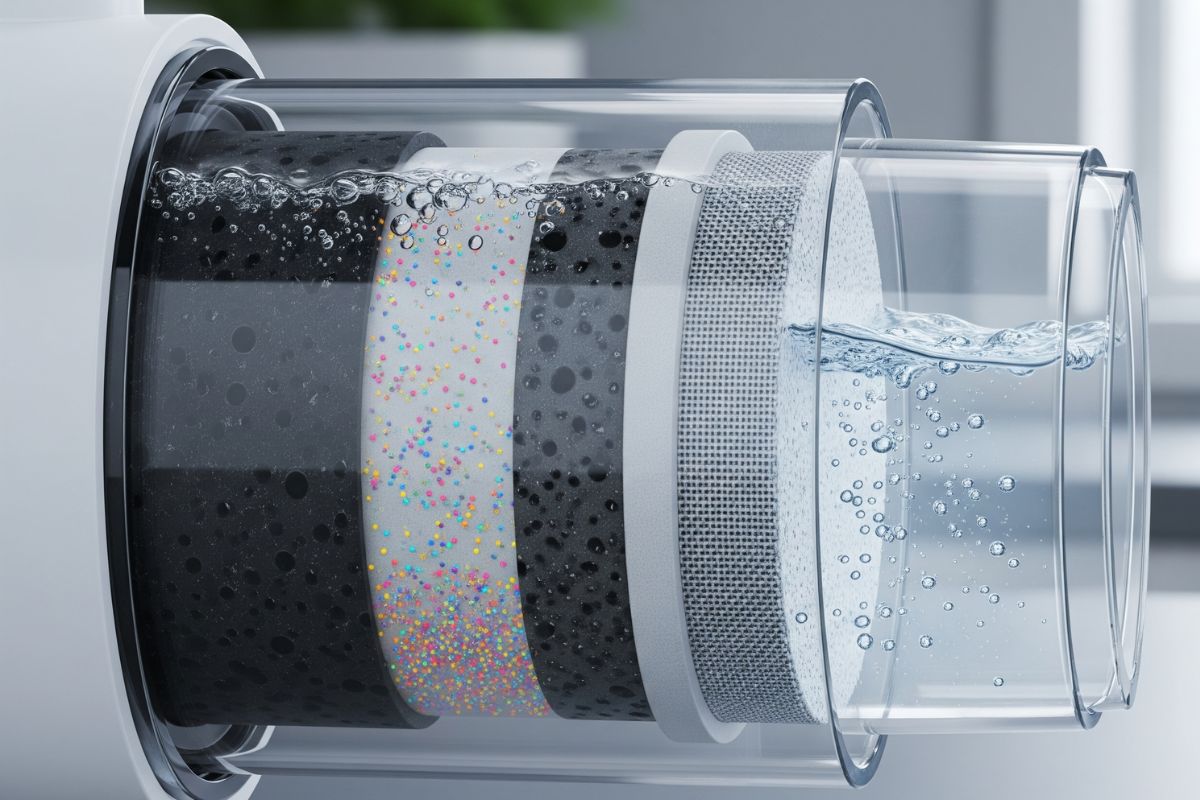Ever sipped from your tap and wondered what’s in there? Tiny plastic bits, that’s what. Microplastics have snuck into our water supplies worldwide, raising eyebrows among scientists and everyday folks alike. But here’s some good news: you don’t need fancy gadgets to fight back. Recent studies point to straightforward methods that can slash these pesky particles right at home.
In this piece, we’ll dive into the nitty-gritty of microplastics in drinking water, how they get there, why they matter, and, most importantly, how to get them out. We’ll cover everything from a surprisingly simple boiling trick to advanced filtration options. Stick around; it might just change how you hydrate.
What Are Microplastics, Anyway? A Quick Primer
Microplastics. Those are the minuscule plastic fragments, often smaller than a grain of rice, breaking down from larger items like bottles, bags, and even synthetic clothes. They measure under 5 millimeters, sometimes dipping into the nano range, and are invisible to the naked eye.
They crop up everywhere. From ocean depths to mountain streams, these bits hitch rides through wastewater, runoff, and even the air. Believe it or not, they’re in our rivers, lakes, and yes, the tap water flowing into your kitchen. Studies show they’re pervasive in both bottled and municipal supplies, with concentrations varying by location.
Why care? Well, they’re not just floating harmlessly. Research links them to potential health issues, though experts stress more studies are needed. For now, it’s about minimizing exposure, kind of like cutting back on junk food, you know?
The Growing Concern: Microplastics in Our Daily Drink
Picture this: you’re filling a glass from the faucet. Unseen, microplastics might be tagging along. Global surveys reveal they’re in 80% or more of tap water samples tested across continents. In some spots, counts reach hundreds per cubic meter.
How do they invade? Mostly through human activity. Plastic waste degrades, fibers shed from laundry, and microbeads from old cosmetics all contribute. Wastewater treatment plants catch some, but not all, especially the tiniest ones slip through.
Here’s the kicker: even treated water isn’t immune. A study in Switzerland found microplastics lingering post-filtration in conventional plants. Raw water there showed 19 to 143 particles per cubic meter, dropping significantly after processing, but not to zero. It’s a wake-up call for better defenses at home.
Health Risks: What Science Says So Far
No one’s panicking yet, but caution is key. Microplastics can carry chemicals or toxins, potentially messing with our bodies over time. Animal studies hint at inflammation, gut issues, or even reproductive woes, though human impacts remain unclear.
One worry? They might accumulate. Researchers have detected them in blood, lungs, and placentas. A recent review tied higher exposure to risks like infertility or certain cancers, but correlations aren’t causations. Still, reducing intake makes sense, especially for vulnerable groups like kids or pregnant folks.
Funny thing is, we’re already ingesting them through food, too, seafood, salt, even beer. Water’s just one piece of the puzzle. The goal? Cut down where we can, starting with that daily glass.
A Simple Hack: Boiling Your Way to Cleaner Water
Now, onto the star of the show. Worried about microplastics in drinking water? Try boiling it first. Sounds too easy, right? But science backs it up. Researchers in China tested this on tap water, adding nano and microplastics to mimic real contamination.
They boiled samples, then filtered out the gunk. Results? Up to 90% removal in hard water, that’s the mineral-rich kind common in many areas. Why? Heating causes calcium carbonate, or limescale, to form. It traps plastics like a net, encasing them in a crust you can skim off.
Soft water saw less success, around 25-30% removal, but still worthwhile. The team used a basic stainless steel mesh, like a tea strainer, to catch the residue. No high-tech needed, just your stove and a simple filter.
Believe it or not, this could be a game-changer globally. In places with hard water, it’s especially potent, potentially slashing human intake through everyday consumption. And get this: it works on nanoplastics too, those ultra-tiny invaders.
Step-by-Step: How to Boil and Filter at Home
Ready to try? It’s straightforward. Here’s a quick guide, broken down:
- Gather your tools. A pot, tap water, and a filter, like a coffee filter or fine mesh strainer. Nothing fancy.
- Boil it up. Pour water into the pot and bring to a rolling boil for a few minutes. Let it cool slightly; that helps limescale form.
- Filter away. Pour through your strainer. The chalky bits? That’s limescale trapping plastics. Discard and enjoy.
- Pro tip: For best results, use hard water. If yours is soft, consider adding a pinch of baking soda to mimic minerals, though test small batches first.
Simple as that. One study showed 84-90% efficiency at higher hardness levels. Repeat for batches, and you’re set. Oh, and if I’m honest, it might even improve taste by reducing other impurities.
Beyond Boiling: Advanced Filtration Methods
Boiling’s great, but not always practical, say, for large quantities or on the go. Enter filters. These come in various flavors, each tackling microplastics differently.
Activated carbon filters, for instance, adsorb contaminants. Their porous surfaces snag plastics alongside chlorine and lead. Ceramic options work similarly, trapping particles via tiny pores.
Reverse osmosis? That’s the heavy hitter. It pushes water through a semi-permeable membrane, blocking even nano-sized bits. Efficiency? Often 99% for micros, per lab tests.
Don’t forget portable solutions. Filtering water bottles with built-in tech let you sip safely anywhere. Just refill from taps, and they handle the rest, removing plastics, bacteria, and more.
Coagulation and Flocculation: The Science Behind Better Removal
Ever heard of coagulation? It’s a process used in treatment plants, but you can mimic it at home with additives. Chemicals neutralize particle charges, clumping them for easier filtering.
In one pilot study, adding coagulants boosted removal to 97% for microplastics over 63 microns. Without? Around 89%. Synthetic fibers saw similar jumps, from 81% to 96%.
At home, it’s trickier; stick to commercial filters that incorporate this. Or, in a pinch, alum-based kits for water purification. But always follow instructions; safety first.
This nesting of methods, boiling plus filtration, say, amps up effectiveness. Layer them, and you’re covering more bases.
Real-World Studies: Efficiency in Action
Let’s look at the data. A Geneva plant study tracked microplastics from raw to treated water. Raw counts: 19.5 to 143.5 per cubic meter. After sand and activated carbon filters? Down to 0-8, with coagulants helping.
Another from China: Boiling hard water at 300 mg/L calcium carbonate nabbed 90% of nano/microplastics. Softer stuff? Less, but still notable.
Globally, tap water contamination varies. EU samples average lower, 3.6 particles per liter, versus higher in the US or India. Treatment plants retain most, but home steps bridge the gap.
Here’s a stat to chew on: One review found 89% retention without extras, jumping with advanced tech. It’s progress, yet room for improvement remains.
On-the-Go Solutions: Filtering Bottles and More
Traveling? Don’t fret. Portable filters are lifesavers. Bottles with integrated carbon or ceramic elements remove microplastics as you drink. Check specs: some last hundreds of uses before needing replacement.
Replace filters regularly, every few months, depending on usage. That ensures peak performance, keeping plastics and other nasties at bay.
For offices or homes, dispensers with patent-pending tech filter and even add minerals. Flavors, too, if that’s your thing. It’s convenient, cutting single-use plastics while purifying.
Environmental Angle: Why Reducing Microplastics Matters Broader
This isn’t just about your glass. Microplastics harm ecosystems. Fish ingest them, mistaking them for food; birds, too. They disrupt food chains, ending up on our plates.
Sources? Laundry’s a biggie; synthetic fibers wash into sewers. Tires wear down, releasing particles via roads. Cutting personal use helps: opt for natural fabrics, air-dry clothes, use laundry bags that catch fibers.
Policy plays a role. Bans on microbeads in cosmetics have curbed some influx. Wastewater upgrades trap more at the source. Your actions? They ripple out.
Home Tips: Preventing Microplastic Entry
Prevention beats cure. Install mesh screens on drains to catch fibers. Choose glass or metal over plastic containers, less.
Filter washing machine outflow if possible. And boil that water; it’s dual-purpose, killing bacteria too.
For bottled water fans: it’s not always cleaner. Studies show similar or higher microplastic levels in some brands. Tap, treated right, often wins.
Challenges in Removal: What to Watch For
Not everything’s perfect. Boiling works best in hard water; soft water needs tweaks. Filters clog over time, needing maintenance.
Size matters; nano bits are toughest to catch. Advanced membranes help, but they’re pricier.
Cost? Basic boiling: free. Good filters: $20-200 upfront, plus replacements. Weigh against health benefits.
If I’m honest, no method is 100%. Combine them for the best odds.
Future Outlook: Innovations on the Horizon
Science isn’t stopping. New tech, like magnetic nanoparticles, can pull plastics magnetically. Biodegradable filters from natural materials show promise.
Research continues: better detection, removal efficiencies. Global efforts aim to slash plastic pollution at its root.
Stay informed. As studies evolve, so do strategies. For now, that boiling pot’s a solid start.
Wrapping It Up: Take Control of Your Water
So there you have it. Microplastics in drinking water are a modern headache, but solutions abound, from a humble boil to high-tech filters. Start simple, build from there.
Remember, every drop counts. Cleaner water means a healthier you… and planet. Give it a shot next time you fill up. You might be surprised.








